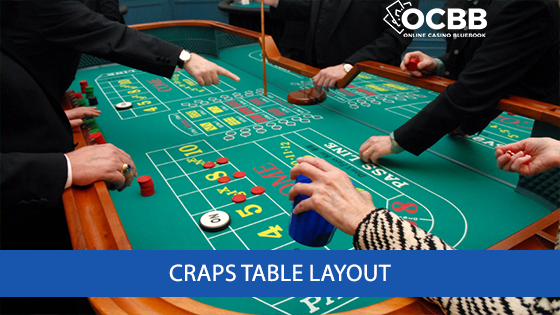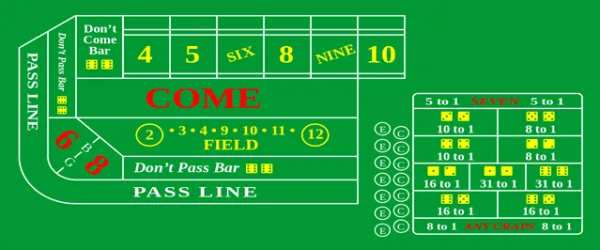Craps Table Layout
Ever rolled the dice at a craps table and felt lost, need a How To Play Craps Guide? Understanding the layout is key to mastering this fast-paced game. In this guide, we’ll break down the components of a craps table, introduce you to the staff running the show, and explain the various betting areas. With this detailed knowledge under your belt, you’ll be playing like a pro in no time!
Key Takeaways
- The craps table layout consists of side sectionds and a center section.
- The side section is where most bets like Pass Line or Don’t Pass are made and is managed by two dealers.
- The center section contains high-risk proposition bets and is controlled by the stickman.
- Understanding the different betting areas such as Pass Line, Place Bets, Field Bets, and Come Bets is crucial for mastering craps and developing effective strategies.
 Layout Components
Layout Components
You’re about to delve into the intricate world of craps table layout, focusing primarily on two key areas: the Side Section and the Center Section. The Side Section, often manned by a dealer who also handles cash transactions, is where you’ll make most of your bets like Pass Line or Don’t Pass. In contrast, the Center Section houses proposition bets managed by a stickman; it’s an area brimming with high risk but potentially high reward outcomes.
Side Section
In the side section of a craps table, you’ll usually find areas for placing hardways and one roll bets. This vital component of the craps table layout is where you and other players can make additional wagers to heighten the excitement of the game.
The side sections are typically managed by two dealers who stand on either end of the table. Their primary role is to handle cash transactions and place bets for players. The side section contains individual boxes with numbers 4, 5, 6, 8, 9, and 10 where you can place your hardways bets.
One roll bet areas are also found in these sections. These spots allow quick betting on a single roll’s outcome – a thrilling chance that adds an extra twist to each round at the craps table.
Center Section
Let’s now turn our attention to the center section of the craps table layout, where most of the action happens during a craps game. This section is primarily controlled by the stickman and contains all proposition bets.
The center section is shared between both sides of the table and can seem chaotic with numerous betting options. However, understanding each bet helps you make informed decisions. Remember, your dealer is there to assist if needed. So don’t hesitate to ask questions about these bets!
The Staff
Now that you’re familiar with the layout of a craps table, let’s dive into the crucial roles that make up the staff: dealers, floorman, boxman, and stickman. Each plays an integral part in ensuring the game runs smoothly and fairly. Understanding these roles not only enriches your knowledge of craps but also enhances your gameplay experience by providing insight into how each position contributes to its unique dynamics.
Dealers
Dealers at a craps table are essential as they’re responsible for managing bets and payouts. On a typical craps table layout, you’ll find two dealers, one on each side of the boxman. Each dealer attends to players on their respective sides of the table.
The dealers’ main tasks include collecting losing bets, paying winning ones, and making sure that the game runs smoothly. They have an in-depth knowledge of all possible bet types and outcomes in craps games. Dealers also guide novice players with betting strategies and rules of craps.
In any casino game, dealers form a crucial link between the casino and its players. During a game of craps, their roles become even more pronounced due to the fast-paced nature of the game and complex betting options available. Remember to tip your dealers; it’s good karma!
Floorman
A floorman oversees the entire gaming area and ensures everything runs smoothly. This individual has detailed knowledge of all games, including a deep understanding of the craps table layout.
As part of their duties, floormen supervise the casinos’ tables, making sure rules are followed and fair play is maintained. They have an eagle’s eye on the craps tables, ensuring that bets are placed correctly according to the specific craps table layout and that payouts are correct.
Being well-versed in casino etiquette and procedures, they can answer any queries about the game or help resolve disputes. So next time you’re at one of these tables in casinos, remember that there’s more to it than just dice – there’s also a highly trained professional keeping things running efficiently.
Boxman
While a floorman is overlooking the entire gaming area, there’s also a boxman who has their own specific duties in the casino setting. The boxman sits directly across from the stickman at the center of the craps table layout. Their position allows them to have a clear view of all aspects of the game. As a player, you’ll interact with the boxman when buying chips or cashing out.
The boxman oversees the financial transactions on the table and ensures that everything runs smoothly during gameplay. They supervise both dealers and players, making certain that rules are followed while maintaining game integrity. They’re responsible for handling disputes and making critical calls in tricky situations. In essence, they are custodians of trust and fairness at your craps game experience.
Stickman
Just like the boxman, there’s also a stickman who plays an essential role in your gaming experience. As you stand around the craps table, the stickman is typically found directly across from the boxman on the opposite side of the table layout.
The stickman’s main task involves managing and controlling all dice rolls. They use a long wooden “stick” to push dice across the craps layout to players, hence their title. In addition, they’re responsible for announcing each roll’s outcome and encouraging bets on particular propositions before a roll.
Understanding these roles in detail helps improve your understanding of this fast-paced game. So next time you’re at a craps table, acknowledge how critical both the boxman and stickman are in facilitating an enjoyable and fair gameplay experience.
Betting Areas
You’ll find several betting areas on a craps table layout, each with its own rules and payoffs. Understanding these sections is paramount to mastering the game of craps because they dictate your possible bets and potential returns.
The most prominent section on any craps table layout is the pass line. This area runs around the entire outer edge of the table and it’s where you make your primary bet. If you place your chips here, you’re essentially betting that the shooter will roll a 7 or 11 on their come-out roll, or establish a point number which they will then hit before rolling a 7.
Another crucial betting area is for place bets. Here, you’re wagering that one of six numbers (4,5,6,8,9 or 10) will be rolled before a seven appears. The payoff differs depending on which number you’ve chosen to place your bet upon.
There are other sections too like field bets and come bets but understanding pass line and place bet areas can give you solid groundwork in playing this exciting dice game. So familiarize yourself with these key areas as part of developing an effective strategy at the craps table.
Conclusion
In conclusion, understanding the craps table layout is crucial for your game success. You’ve learned about the different components, staff roles and betting areas that make up this complex game. This knowledge can undoubtedly enhance your gaming experience and increase your winning chances. Keep practicing, and soon enough you’ll master the art of crapping like a pro! Make sure to read about the fascinating history of craps here!
 Frequently Asked Questions
Frequently Asked Questions
What are some strategies to win at a table?
Master the game’s basics first. Focus on Pass Line bets, as they’re simplest with a low house edge. Use odds bets to your advantage, increasing them when winning. Remember, consistent strategies often yield better results.
How do the odds change depending on the type of bet?
In craps, odds vary significantly based on the type of bet. For instance, Pass Line and Don’t Pass bets have lower house edges than Any Seven or Hard Ways. Therefore, understanding the different bets can enhance your winning chances.
What is the history behind the layout design?
The craps table layout design dates back to the early 1900s, influenced by several dice games. It’s meticulously structured to accommodate various types of bets, reflecting the complex and strategic nature of the game.
Are there different variations of table layouts in different regions or casinos?
Yes, there are variations in craps table layouts among regions and casinos. They’re primarily designed for convenience and to accommodate local betting culture. However, the basic structure remains consistent across most versions.
How can I practice understanding table layout before playing in a real game?
You can practice understanding the craps table layout by studying diagrams online, playing virtual games, or using home craps sets. This helps familiarize you with bet placements and game rules before real casino play.




